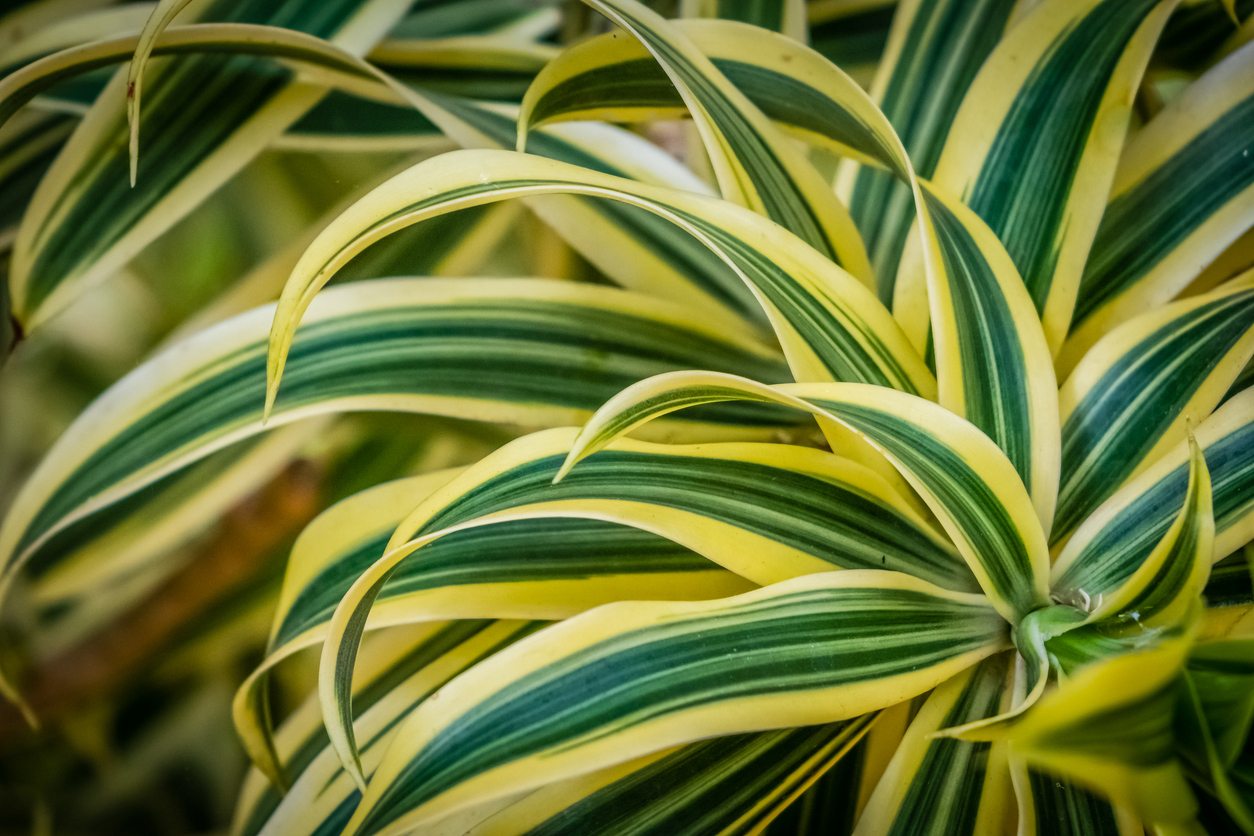You just can't go wrong with Draceanas!

It’s hard to go wrong with dracaenas, they help to purify the air we breathe indoors, are low-maintenance and can even withstand a certain amount of neglect, and because they store water in their trunks, they are drought resilient, in case you forget to water them occasionally. There are many exciting cultivars and their long, glossy green leaves come in many sizes, from broad to delicately thin, and in zesty, fresh colour variegations, with stripes of green and white, red, pink, yellow and chartreuse. Occasionally the plants set clusters of small, fragrant, white blossoms but rarely flower indoors. Draceana marginata 'Tricolor'Young plants are small and bushy, and are often sold in pots where several stems of varying heights are planted together, giving them a lovely full look, and because they are slow growing, they make perfect long-time residents for table and counter tops. Draceana species vary in height but they all slowly develop long, elegant stems, and this, combined with their lush foliage makes them great stand-alone plants, and wonderful combined with other plants, adding a tropical ambiance to gardens and indoor décor. Draceana belongs to the asparagus family (Asparagaceae), and the genus dracaena comprises of about 40 species. The majority of the species are native to Africa, southern Asia through to northern Australia, with two species in tropical Central America. The origin of the plant name Draceana comes from the ancient Greek word “drakaina” which means “female dragon,” and was given to Draceana due to a red gum-like resin in their stems that was likened to dragon blood.Various beautiful cultivars are available to gardeners including those listed below. Visit a retailer to find the perfect one for your garden or home.
Dracaena reflexa 'Song of India'
Dracaena reflexa 'Song of India' is sometimes sold as Pleomele reflexa. It is one of the most visually striking houseplants, and because it is very slow growing, developing to about 1.8m in height over many years, it is ideal for smaller pots in the office or home. The narrow, pointed leaves are 15 to 20cm long, and green, edged with a broad band of chartreuse yellow. In subtropical regions song of India is striking if planted in the garden, or in pots in a shady outdoor area, like a patio. In garden beds it needs bright, indirect light. Intense, direct sun will burn the leaves and low light will cause the plant’s yellow-lime striped vibrancy to fade, and the growth of the plant will be spindly. Mild morning sun can be an option. In tropical gardens it used as an evergreen focal plant where it can grow to an impressive height of 5.5m with a spread of 2.5m.
Draceana 'Lemon Lime'
Dracaena lemon lime is a sport of Dracaena deremensis, and that also makes Lemon Lime related to Dracaena Janet Craig and Dracaena Warneckii. The plant is sometimes referred to as ‘Dracaena fragrans‘, referencing the plants highly fragrant flowers. As its name suggests, this is a vibrantly fresh looking Dracaena with a predominantly lemon-lime background colour, sometimes tending towards yellow, with a central stripe of darker green, edged in white. Indoors it requires plenty of bright, indirect light to retain its vibrant colouring. Avoid direct sunlight which can scorch the leaves. It has lovely long, arching, lance-shaped leaves, and the multi-stem version gives a unique look, providing height in tiered levels of foliage. Its zesty freshness brightens up gardens, homes and office interiors, and because it grows slowly, it can fit in a particular space for a long time without requiring much maintenance. Its ultimate height indoors is about 1.5 to 2m, but outdoors it can reach 7m in height. Choose a spot in the garden that is not in direct sun, but which receives a lot of bright, indirect light.
Uses:
Centuries ago, the resin of these plants was used for toothpaste, dyes, and medicines. Today, it is still used for varnish and photo engraving.
In the Home & Garden:
These easy to grow and forgiving plants are perfect for the novice gardener. They are excellent to use in darker areas indoors and will grow easily in artificial light in offices. Indoors they make striking, table plants or short trees, and not only does their dramatic foliage and beautiful colour patterns make a great focal point in any room, they can also help improve air quality. According to research conducted by NASA, dracaenas can clean benzene, carbon dioxide, formaldehyde and trichloroethylene from indoor air.If grown in the garden in warm, frost free zones they are wonderful to use as focal plants or as a unique hedge or flanking plant at entrances.
Cultivation:
Indoors:
When growing dracaena plants indoors, as with most potted plants, location is of prime importance. Although they are known to tolerate low light conditions, and grow well in artificial light indoors, doing well in brightly lit offices and homes, they thrive in natural, brightly filtered light, such as through a sheer curtain in front of a sunny window, or in a bright shady spot. Varieties sporting bright colours always require bright light, because if the light is too low they will lose the vibrancy of their colours. Never place the plants where they receive direct sun, as the rays will scorch their foliage. Also, keep in mind, plants kept in lower light situations will grow slower and produce smaller leaves.Draceanas are forgiving of temperatures, as long as they are not too cold. Room temperatures between 18 to 24°C are ideal daytime temperatures. In winter, temperatures below 13°C will harm the plant, so keep your dracaenas away from cold drafts from open windows and doors. Also, make sure that you display them away from any heating or cooling appliances.Dracaena marginata 'Tricolor'Dracaenas are tough indoor plants and will tolerate the natural humidity indoors, but because they prefer the higher humidity of their natural rainforest habitat, they will greatly enjoy higher humidity indoors. If you see their leaf tips turning brown, that's often a sign that the humidity is too low, and misting the leaves down regularly with water will help to prevent this, as well as keeping them looking clean, fresh and healthy.Another way of increasing humidity around the leaves is to place fine gravel or pebbles in the drip tray and filling the tray with water to just below the bottom of the pot. It is important that the pot does not stand directly in the water as this can cause root rot. As the water evaporates, it will add humidity to the surrounding air. You can also improve humidity with a commercial humidifier. Wiping both the upper surfaces and undersides of the leaves regularly with a damp cloth will keep them clean, and allows the plant to exchange air freely. Do not use leaf shine on these plants.Draceanas require a good quality potting soil which drains well, and although they require less water than most indoor plants, they should still be watered regularly in summer. Watering about once a week or so should suffice, but this can vary depending on the size of your plant, and the size of its pot. For best results keep the soil slightly moist but not soggy, always allowing the top soil to dry out before watering again. To check the moisture levels most gardeners gently insert a finger into the top soil to check, but if you are a novice gardener, this is where a moisture meter may come in very handy for all your potted plants. In winter reduce the amount you water, especially in cold regions. And if you are growing dracaena in low light it will not require as much water as those growing in warmer, brighter conditions.Dracaena trees are sensitive to salts, minerals, fluoride and chlorine in tap water, so try to use rain water or purified water when caring for this plant. If you don’t have rain or purified water you can use tap water, but let the water sit for 24 hours in a bucket before giving it to the plant. This will allow for some of the unwanted materials to evaporate. Leaves with dark brown and dead areas with yellow edges may indicate fluoride toxicity.Drooping or yellowing leaves indicate over-watering or poor drainage, but don’t worry if you notice the bottom leaves beginning to turn yellow and fall, as it is normal for dracaenas to shed their lower leaves in order to grow new ones, and as the lower leaves fall of they form their long canes. Because dracaenas grow slowly it is not necessary to overfeed them, but a light feed every month or two in summer with a balanced houseplant fertiliser will keep them looking at their best. As the plants benefit from a period of winter dormancy, reduce feeding and watering in autumn, and stop feeding completely during the winter months.Rotate potted dracaenas weekly so that they don’t grow toward the light, become one sided, and lose their beautiful shape.As with most pot plants dracaenas like to be a bit pot bound and do not require huge pots. Repot into slightly bigger pots about every two to three years, or when their potting media is exhausted.


